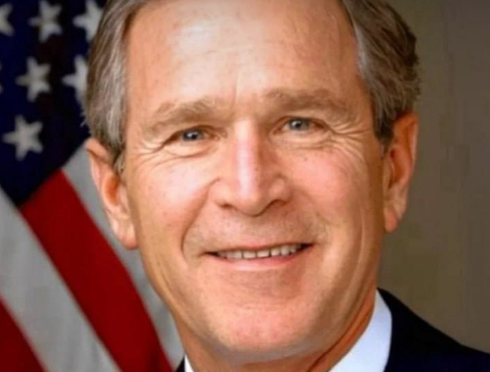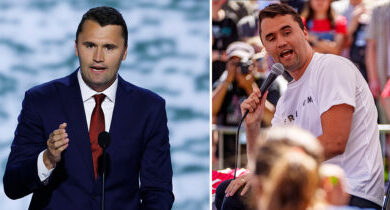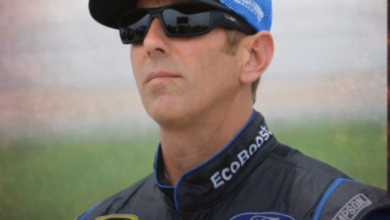
Former President George W Bush recently made headlines
Former President George W. Bush, a figure who has long been associated with grit, humor, and a quiet sense of determination, stepped back into the national spotlight in an unexpected way at the World Series opener. On that crisp evening, Bush was tasked with one of baseball’s most iconic ceremonial honors: throwing the first pitch. What seemed at first like a straightforward nod to tradition quickly became a moment that reminded the public of the challenges even a former president quietly shoulders.
When Bush stood on the mound, fans cheered, appreciating both the weight of his legacy and the sheer nostalgia of his presence. But the pitch that followed veered off course, noticeably missing its target. In a stadium where every detail is scrutinized, such a moment immediately raised questions. Was this simply a misfire, or was there more to the story? The answer soon came from his daughter, Jenna Bush Hager, who revealed that her father had undergone back surgery earlier in the year.
Speaking candidly, Jenna admitted she was worried about her father. She explained that the surgery—specifically a spinal fusion procedure on his lower back—likely influenced his throw. The revelation shed light not just on the mechanics of a baseball pitch but on the resilience of a man who continues to push himself despite physical limitations. Her remarks gave fans a glimpse into the private life of the former president, where family concern and personal determination intersect with public appearances.
A spokesperson for Bush later confirmed Jenna’s account, noting that while Bush would never lean on excuses, it was true that his surgery had left lingering effects. “President Bush isn’t one to make excuses, but it’s true — he did have fusion surgery on his lower back earlier this year,” the spokesperson said. The statement was measured, designed to reassure the public that his health challenges were real but not debilitating. It added a layer of context that reframed the pitch not as a stumble but as a quiet act of persistence.
For Bush, the choice to step onto that mound carried a significance that went far beyond the pitch itself. At 78 years old, he had every reason to decline the invitation. Recovering from spinal surgery is not a simple matter; it requires patience, physical therapy, and the kind of stamina that can wear down even the strongest personalities. Yet, Bush chose to accept the role, embodying the same attitude that marked his years in office: a willingness to face challenges head-on, no matter the outcome.
What makes this moment resonate is not the imperfect throw but the symbolism behind it. Ceremonial first pitches are meant to honor tradition, celebrate legacy, and bring a touch of humanity to America’s pastime. By showing up despite his physical hurdles, Bush reminded the public that resilience does not always look polished. Sometimes it looks like a man with a healing back standing before thousands, willing to risk an errant pitch because the act itself matters more than the precision.
Jenna’s comments added a deeply personal perspective. For her, the sight of her father on that field was not simply about baseball—it was about witnessing someone she loves continue to test his limits. Her concern was rooted not in embarrassment over the pitch but in recognition of the physical sacrifices her father has endured. The protective instincts of a daughter collided with the public role of a statesman, and that tension gave the story emotional depth.
Bush’s appearance also highlighted something often overlooked in public life: the reality that even leaders, long out of office, face the same frailties as anyone else. Aging, surgery, recovery—these are universal experiences, yet when carried by a former president, they take on symbolic weight. His presence on that mound wasn’t about demonstrating perfection but about acknowledging perseverance in its truest form.
In an era where public figures are often judged by their precision, polish, or performance, Bush’s throw offered something different. It was raw, imperfect, and undeniably human. The moment could have been dismissed as a blunder, but with the context of his surgery and recovery, it instead became a testament to the stubborn strength that has always defined him.
Beyond the pitch, Bush’s decision to show up spoke to his ongoing commitment to the role of a public servant, even in symbolic gestures. While his presidency ended years ago, his willingness to step into the spotlight for moments of national unity has not waned. For him, honoring America’s traditions and participating in collective rituals like the World Series opener is less about personal performance and more about reinforcing shared identity.
Ultimately, George W. Bush’s first pitch at the World Series opener was far more than a throw gone astray. It was a moment that intertwined personal struggle, public duty, and the resilience of an aging statesman who refuses to bow out quietly. It reminded the country that strength does not always manifest in flawless execution—it often shines brightest when someone dares to show up, despite the odds, despite the risks, and despite the possibility of falling short.
At its core, this story is not about a pitch that went off target. It’s about a man who, after facing back surgery and the challenges of age, chose to stand before thousands, to accept the responsibility and the spotlight, and to deliver the best he could. That imperfect throw became a symbol of resilience, humility, and courage—qualities that, in the end, are far more memorable than any perfect strike across the plate.




